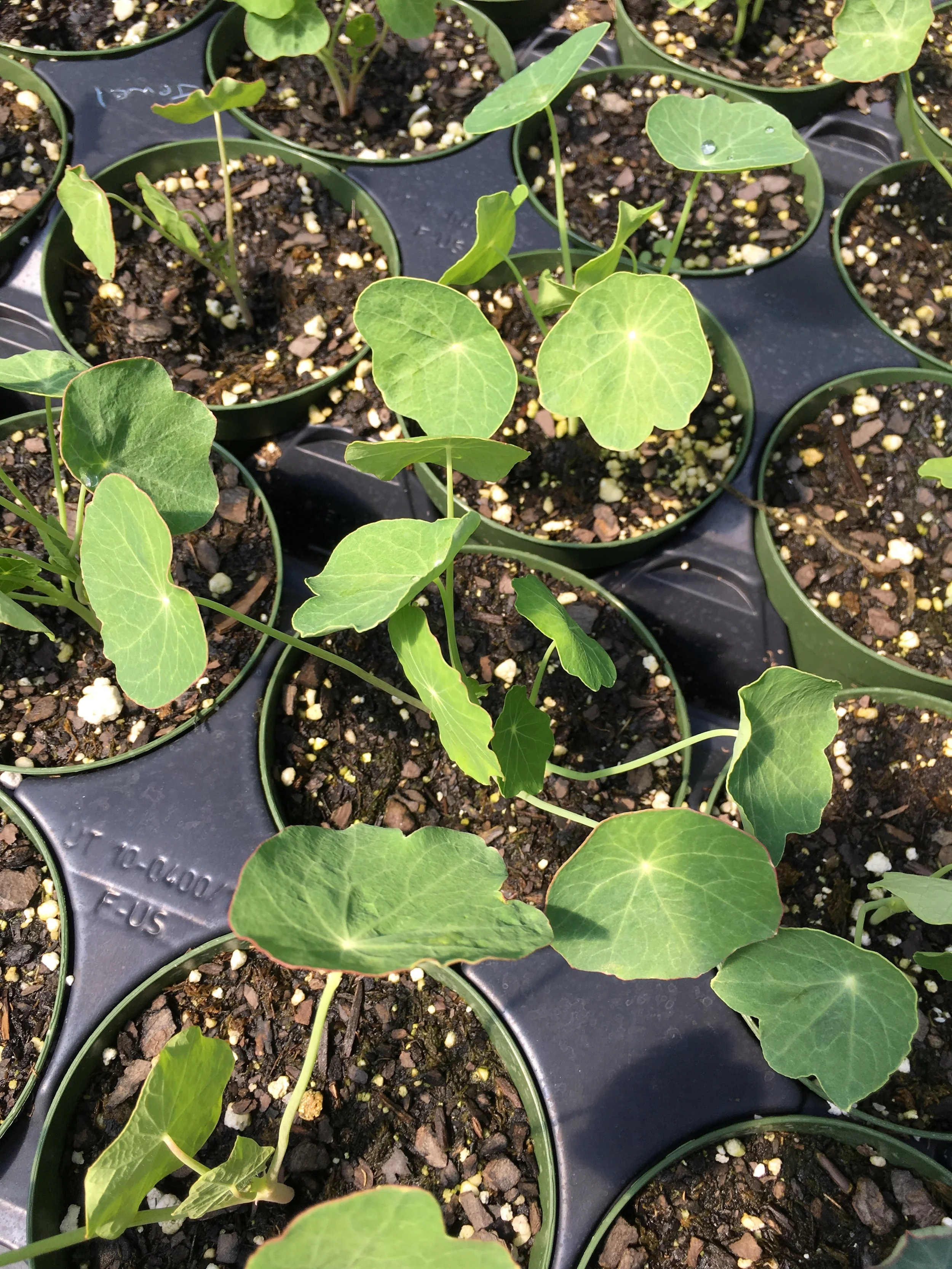Nasturtium



Nasturtium
Organically grown - currently available for pick up only. Plants are not currently flowering and are approx. 4" x 4".
Nasturtium has a great many culinary uses and produces beautiful edible flowers which have a pleasant rose like scent. Easy to grow and requiring little care, they make a great hanging basket, potted plant or addition to your herb garden.
- USDA Zone: 9 - 10
- Height: 6 - 12 in
- Width: 6 - 12 in
- Exposure: Full Sun to Part Shade
- Water regularly, do not over water
Nasturtium Leaves: The most familiar and commonly used part of the plant. The tender leaves have a slight peppery bite to them and are similar to watercress in flavor. The leaves store well in a sealed plastic bag in the refrigerator for 3-5 days.
- Nasturtiums are less spicy when picked young and tender. The older the leaves are, the spicier the flavor.
- Leaves can be stuffed with tuna or chicken salad, then rolled up as an entrée or snack.
- Use in risottos, soups, juices, casseroles, pesto and rice.
- Stuff and bake them as you would grape leaves. Try a mixture of rice, currants, nuts and savory spices like cinnamon, mint and cloves.
- Make vinegar using the leaves, buds and blossoms and a bottle of white wine or champagne vinegar.
- Try them stir fried, wilted with other greens or mince and add to chilled summer soups.
- Chop or slice leaves into small pieces and use them instead of green onions or garlic.
- Grind or mince the chopped leaves with salt, chilies and garlic until they form a paste. Use to flavor stir fries or other dishes.
- Nasturtiums are not only beautiful and edible, they have health benefits as well. The leaves are high in vitamin C and also have strong anti-bacterial and anti-tumor properties. Tea made from the leaves is a common preventative for colds and flu.
- Grinding the leaves in water and straining is an easy way to make an all-natural disinfectant wash for minor cuts and scrapes.
- If leaves and flowers are chopped up finely and added to other greens and vegetables, the warmth in their flavor is not as noticeable.
Nasturtium Flowers: Pick blossoms the same day as using, as close as possible to serving time. Store in the refrigerator if eating or a vase to enjoy their beauty and fragrance. Nasturtium cut flowers last several days in a vase and make a pretty arrangement with other herb flowers.
- Stuff fresh blossoms with a blend of soft cheese (like goat, ricotta or cottage cheese) and fresh herbs, salmon or minced dried fruits.
- Mince the blossoms, add a little lemon peel and blend into fresh butter.
- Use the zesty-tasting flower instead of mustard in sandwiches.
- Make nasturtium oil by blending your choice of oil with a handful of blossoms and a clove of garlic. Strain before using.
Nasturtium Buds: Make sure the buds are fully closed and leave a bit of the stem attached when picking and use fresh just as you would the leaves to add a peppery zip to dishes and salads.
- Wash, drain and cover with boiling vinegar in a covered jar for pickled buds that taste just like capers.
- Add a fresh kick to salads like tabbouleh, potato and pasta salads.
Nasturtium Seeds: Nasturtium seeds can be harvested green, as soon as the flowers have fallen off (immature for eating). Or harvest when mature (brown) for seed saving after they have fallen from the plant.
- Nasturtium Pepper – MYO Seasoning! Lightly roast the mature brown dried seeds on an oven tray and then grind in your pepper grinder (or mortar & pestle).
- Nasturtium Capers – Collect flower buds while they are still tight heads. Harvest the unripe green seeds before they harden and fall to the ground. They have a similar taste and texture to capers so make a great substitute. Wash and add buds and seed pods to a clean glass bottle. Add enough vinegar to cover and your pickled capers will be ready to eat in just three days!
Health Benefits: Helps form blood cells, ladies problems, colds, fungus and are anticancer agents.
